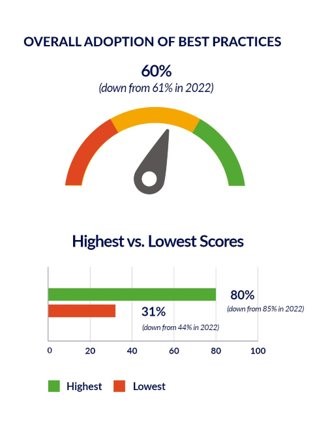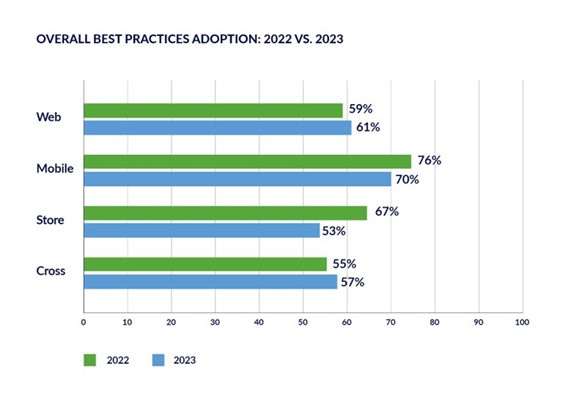Over the past several months, we’ve benchmarked 120 retailers and brands across 14 verticals for our annual Omnichannel Retail Index (ORI) study. Going on our eighth year, ORI takes the pulse of digital commerce and omnichannel retail for our industry. As with every year, we assess the companies benchmarked and update the criteria as best practices become table stakes and innovation becomes best practices. Some criteria get removed due to changes in CX and customer expectations. We spend hundreds of hours mystery shopping and observing how retailers and brands deliver on the omnichannel promise so we can share the key findings with you and help you prioritize your digital and omnichannel roadmap and, ultimately, make smarter investment decisions.
So, here we go.
- Average best practices adoption dropped slightly from 61% in 2022 to 60% in 2023. The gap between the highest scorer and the lowest scorer also widened this year. Overall, retailers and brands have not made any significant leaps in adopting best practices year over year, most likely due to continued economic uncertainties and supply chain and logistics challenges. These obstacles have forced them to pivot strategies to cost-cutting and to reprioritize omnichannel functionalities (such as BOPIS and curbside offerings).

- Although the web and cross-channel best practices adoption increased slightly in 2023, there was a bigger drop in mobile and store channel criteria adoption. The average in-store adoption decrease was caused by factors like lower adoption of in-store shopping tools (e.g., associates using tablets or mobile devices to look up inventory, product information, clienteling info, etc.) — a 33% adoption in 2023. Another factor was the decreased adoption of retailers and brands providing an option to have your receipt emailed to you (59% adoption in 2023). The average cross-channel adoption increase was caused by high adoption of these offerings: During BOPIS, sending an email to customers when the item was ready to be picked up (99% adoption in 2023) and having orders ready for pickup in under 3 hours (75% adoption in 2023). Interestingly, some retailers had the opposite YoY movement than the overall adoption, which means we are not seeing a consistent trend across all companies.

- Vertical winners: The Office/Electronic vertical continues to lead the pack with the highest best practices adoption again in 2023 with 75% (up from 70% in 2022). Department Store maintains second place with 69% adoption of best practices (up from 66% in 2022). Home Improvement steps up to third place, leapfrogging Home/Homeware and Pet verticals with 66% adoption of best practices (up from 63% in 2022).
- The Loyalty category was expanded for the 2023 Omnichannel Retail Index benchmarking study due to retailers’ and brands’ renewed focus on loyalty programs and offerings. It was one of the top categories for best practices adoption across all verticals (73%). Some of the best practices criteria for loyalty include having a tiered loyalty program and getting special benefits for being a part of the loyalty program (e.g., pre-sale, early releases, exclusive offers, events). Out of all verticals, Department Stores led the charge with almost 90% of all loyalty best practices adopted. The vertical lagging behind was Jewelry, with 51% of the best practices criteria adopted.
- Compared to 2022, the average adoption of the Shipping & Delivery category best practices dropped slightly, according to the 2023 ORI. Some of the best practices criteria include having a specific expected delivery date (not just a range) on the product detail page and offering free shipping (outside of promotions). As pressure on expenses hit the bottom line, retailers have had to relook at the cost implications of free shipping, and we are seeing change happening on threshold levels and testing of shipping offers.
Out of the 200+ criteria benchmarked across web, mobile, store, and cross-channels, we can understand the industry and vertical’s best practices adoption for 2023 and the YoY change to see what types of features and functionalities have jumped to meet today’s customer expectations and demand. Contact us to learn how to leverage this data for your company and see how you stack up.
Download the Executive Summary Report to get the full picture.




